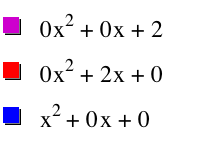
Investigation of Parabola's
by
Molade Osibodu

Investigation of Parabola's
by
Molade Osibodu
Objective: To show the transformation of quadratic functions when a, b and c are varied.
The typical quadratic equation is ax² ± bx ± c . An example of such an equation could be 2x² + 3x - 4. The graph of a quadratic equation is usually a parabola which opens upwards or downwards.
The graphs of parabolas with a = ±1, b and c zero are shown below:

Figure 1: y = x²

Figure 2: y = -x²
From both graphs above, we have the following observations:
* vertex is at x =0
* When a is negative, the graph inverts
Now, we will investigate the changes in the graph when a varies. Let us consider the equation ax² + 2x - 4. We will vary a from -5 to +5. The animation is shown below.
Movie 1: ax² + 2x - 4 with a varying ±5
A screen shot showing the graphs overlaying is also shown below


Figure 3: Graph showing all the equations
Observations:
* The y-intercept stays constant at (0,- 4). Note that - 4 is the value of c.
* The vertices of the graphs vary. When a is negative, the x component of the vertices are greater than 1 and when a is positive, the x component of the vertices are less than 1.
* When a is negative, the parabola opens downward and when a is positive, it opens upward.
* When a is negative, the graph stretches as a increases. When a is positive, the graph shrinks as a increases.
* When a is zero, the graph is a straight line with origin (0,0). Note that when a is zero, the equation becomes 2x - 4 which is a linear function (Review).
Next, we will investigate the changes in the graph when b varies. Let us consider the equation x² + bx - 4. We will vary b from -5 to +5. The animation is shown below.
Movie 2: x² + bx - 4 with b varying ±5
A screen shot showing the graphs overlaying is also shown below


Figure 4: Graph showing all the equations
Observations:
* The y-intercept stays constant at (0,- 4). Note that - 4 is the value of c.
* When b is negative, the x component of the vertices are greater than 1 and when b is positive, x component of the vertices are less than 1.
* Also notice that the graphs on the left are symmetric to the y-axis.
* When b is zero, the vertices of the graph is at (0, - 4) and it does not have a y-intercept. Note that the resulting equation is x² - 4 which is the graph of x²
shifted down by four units (Detailed explanation in the investigation of c below).
* The graph shifts horizontally.
Lastly, we will investigate the changes in the graph when c varies. Let us consider the equation x² + 2x - c. We will vary c from -5 to +5. The animation is shown below.
Movie 2: x² + 2x - c with c varying ±5
A screen shot showing the graphs overlaying is also shown in Figure 5 below


Figure 5: Graph showing all the equations
Observations:
* Unlike the variation of a and b, the y-intercept when c is varied changes. The y-intercept increases as the value of c increases.
* The y-intercept of each graph, is the value of c from the equation.
* The x component of the vertices are constant.
* When c is zero, the y-intercept is at (0,0).
* The graphs shifts vertically.
Let us finally investigate what happens when a and b are zero, a and c are zero and when b and c are zero. The equations and graphs are shown in Figure 6 below.


Figure 6: Graph showing all equations
Observation:
* When a and b are zero, the equation becomes a straight line with y = 2.
* When a and c are zero, the equation becomes linear: y = 2x. This, the resulting graph is a straight line with origin (0,0).
* And finally, when b and c are zero, the equation becomes quadratic y = x² with vertex (0,0)
In conclusion, we can see that the value of a, determines if the parabola opens upward or downward, the value of b shifts the parabola to the right or left and the value of c shifts the parabola upwards or downwards.